|
|
 |
 |
|
COVER STORYHomeward BoundMark Weiner ’04 helps Hurricane Katrina evacuees reclaim their communitiesBy Martina Brendel ’05
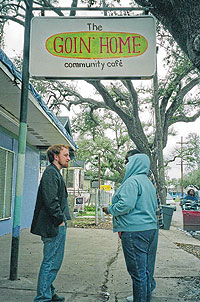
Mark Weiner ’04 chats with fellow relief workers outside The Goin’ Home Community Café in the Lower Ninth Ward. Photo: Martina Brendel ’05  It’s a brilliant day in southern Louisiana, and Mark Weiner ’04 is cruising down Highway 23 on his way to Buras, the coastal fishing community where Hurricane Katrina made landfall. Hank Williams is playing on the stereo of his 1993 Jeep Grand Cherokee, and Weiner is tapping the steering wheel and singing along. “My bucket’s got a hole in it,” he sings. “I can’t buy no beer.” Outside, it’s the closest you can get to the tropics in Louisiana. Satsuma oranges ripen in the orchards and the Gulf Coast glitters a deep Mediterranean blue. Details, however, betray that something is amiss. The trees are a dull gray, killed off by the saltwater that flooded the area for two weeks after the storm. The local high school is boarded up, with no evidence of reconstruction in sight. “When I came down here,” says Weiner, “there were still rotting corpses of farm animals in the trees.” Weiner, 25, is the founder and executive director of Emergency Communities, a disaster relief organization that runs a kitchen and community center in Buras, 70 miles south of New Orleans, and the New Orleans’ Lower Ninth Ward as well as a now-closed site in St. Bernard Parish, just east of New Orleans. Nearly a year after FEMA and the Red Cross halted direct services to the area, Emergency Communities is open daily from 6 a.m. to 9 p.m., providing free meals, showers, laundry facilities, Internet access and after-school programs. Weiner founded Emergency Communities with the belief that in times of strife, what people need more than anything is a place where they can gather and talk about what needs to be done. With that in mind, his organization serves home-cooked meals, often prepared with local ingredients, in a setting that encourages residents to mingle and linger. Artwork and posters advertising health clinics and community meetings decorate the walls. Residents sometimes act as guest chefs, showing the volunteers how to properly prepare a pot of seafood gumbo or red beans and rice. 
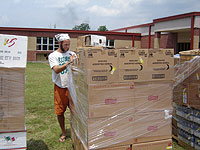
Jason Burwen ’04 checks the first shipment of food to Emergency Communities’ kitchen in Violet in June 2006. photo: jennifer clutterbuck  “There’s a severe lack of resources or any type of services in these areas, and that goes back to way before the hurricane,” says Weiner. “But there is this drive, for people who’ve lived there for generations, to come back. Everybody knew each other. It’s where they went to church. That sense is still there, when people talk to each other, of this thick sense of community.” Weiner, who tends to twirl his fiery red hair absentmindedly, is extremely confident; he has no reticence about walking into a room full of strangers and asking them for donations. His confidence stems in part from a deep conviction about what he’s doing, and it’s infectious to those around him. “He’s somebody who was always extremely confident in his ability to figure things out, and also, he has great people skills,” says Mike Agresta ’04, Weiner’s College roommate, who served as Emergency Communities’ director of outreach and development, a paid position, from February to August 2006. Weiner was a paralegal at Kalow & Springut, an intellectual property law firm in midtown Manhattan, and preparing for law school when Hurricane Katrina struck. He was horrified by the images he saw on television of poor, mostly black New Orleanians wading through water up to their necks, suffering through squalid conditions in the Superdome and being air-lifted from the roofs of houses. 
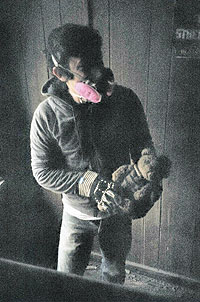
Volunter Chris Famighetti removes a teddy bear from a boy’s bedroom while gutting a house on Tupelo Street in the Lower Ninth Ward. photo: Martina Brendel ’05  “It hit me very hard,” he says, “because it didn’t make sense. Not the severity of the storm, but the lack of response to it. It was such a failure.” Weiner always has been sensitive to matters of racial and class inequality. He grew up in a working class, mostly Hispanic neighborhood on Chicago’s West Side and attended magnet schools, where the student population was balanced to reflect the racial make-up of the city. His parents were socially progressive; as a child, he often accompanied them to rallies in Washington, D.C., and on trips to Michigan, where they passed out pamphlets to striking auto workers. At Columbia, Weiner had little time for activism. He worked 20 hours a week and spent the rest of his time studying. During the course of four years, he held a variety of jobs on campus, from swiping IDs in John Jay to shelving books in Butler. For a while, he was an events coordinator in Lerner Hall and watched as his friends walked past on Friday and Saturday nights. When his shift ended, he would head up to the WKCR studios, where he hosted a late-night blues program. Weiner majored in history and took a special interest in post-colonialism. He was particularly influenced by the writings of Edward Said, the Columbia English professor who articulated and critiqued the concept of Orientalism, or the subjugation of Eastern peoples by Western scholars. Said’s writings revealed to Weiner a more nuanced understanding of history, as a back-and-forth between actors rather than just a class struggle between the rich and poor. “It was very different from the way I had been viewing history,” he says. “The oppressed were not just symbols. They weren’t mute. They were very much actors in the movements of history.” After graduation, Weiner followed his then-girlfriend to Montana, where he took a job giving bus tours of Glacier National Park. He loved it, but after five months decided it was time to get serious. He returned to New York and began laying the groundwork for a law career. 
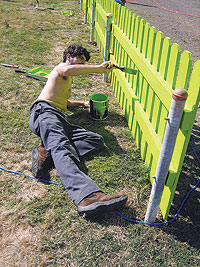
Mike Agresta ‘04 paints a fence in Diamond Trailer Park in Plaquemines Parish last summer. photo: Katherine Pangaro  When Katrina struck, Weiner decided to throw a fundraiser for the Red Cross in his Clinton Hill apartment. He bought several kegs of beer and charged $10 at the door. Halfway through the party, he killed the music, turned up the lights and made a little speech about the hurricane. “Right after doing that, I thought, ‘I want to go down there,’” recalls Weiner. With the LSATs under his belt and three years of law school looming on the horizon, he thought, “I have one year to do something different. Forget it, I’m going to New Orleans.” Weiner applied to volunteer with the Red Cross but, like many others, was told his services weren’t needed. Through his friend, Mischa Byruck ’04, with whom he had studied in Chile, Weiner learned of a soup kitchen in Waveland, Miss., run by the Rainbow Family, a bohemian group known for participating in spontaneous outdoor gatherings such as the annual Burning Man festival in the Nevada desert. Byruck and his friend, Jason Burwen ’04, were at Burning Man when Katrina struck. Rather than return to San Francisco, where they had been hunting for jobs and an apartment, they decided to go volunteer. Weiner quit his job, sublet his apartment and, with what savings he had, made the trip to Waveland in October 2005. When he arrived, he was impressed by what he found. The Rainbows were not only providing meals but also first aid and other critical services they had picked up while running outdoor concerts. At night, they slept in tents in a makeshift campground near the kitchen. 
Most volunteers are students, retirees,  “It was a place where you could help so directly,” says Weiner, who worked mostly as a dishwasher. “It didn’t require the bureaucracy that was hampering relief efforts.” In early November, the Rainbow Family decided to pack up its site. Weiner pulled Byruck and Burwen aside and said, “We could turn this model of relief into an organization.” Then it would be eligible for grants, he explained, and have the infrastructure to support multiple relief sites. Besides, he said, there were plenty of other college graduates out there like themselves who were sick of office work and wanted to have an impact on the world. “He took the helm with it,” says Burwen. “I don’t know if he had the full vision, but he definitely had a vision.” Weiner returned to New York on November 4 to set up the organization while a friend scouted for a relief site. He turned his Brooklyn apartment into a day-care center for cats and dogs to pay the rent while he got the project off the ground. With help from his law firm and the book Nonprofits for Dummies, Emergency Communities was born. 
“They give their word and they get the job done.”  Emergency Communities is headquartered in Weiner’s one-bedroom apartment in uptown New Orleans. The organization has three paid employees — Weiner, a director of development and a volunteer director — and between 40 and 140 volunteers at any given time. As of spring break, nearly 4,000 volunteers had participated in the organization. 
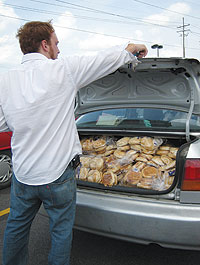
Weiner unloads a trunk full of rolls for pulled-pork sandwiches in St. Bernard Parish. photo: Katherine Pangaro  Almost all volunteers find Emergency Communities through Google, which awarded the organization a grant early on that places its website at the top of any search for “New Orleans” and “Volunteer.” Most volunteers are students, retirees, unemployed or self-employed. An attitude of self-sufficiency permeates Emergency Communities from top to bottom. Instead of standing around waiting for directions, volunteers are encouraged to do whatever job it is they see needs to be done, whether it’s clearing a table or shingling a roof. As a result, the organization gets things done with impressive speed. Three weeks after Weiner signed the lease on a building in the Lower Ninth Ward — a poor black neighborhood in east New Orleans and the site of the first levee breach — it had been gutted and cleaned, the electricity and plumbing were up and running and volunteers were serving three meals a day. It even had a name: “The Goin’ Home Community Café.” “I would equate them to nonprofit Marines,” says Gary Ostroske, executive director of the United Way of Greater New Orleans. “Early on after Hurricane Katrina, people said, ‘You can’t go there. There’s no electricity.’ They said, ‘We’ve got generators.’ People said, ‘There’s no food.’ They said, ‘We’ll cook.’ People said, ‘There’s nowhere to sleep.’ They said, ‘We’ve got tents.’ They get the job done and that, to me, is the most important thing after the disaster. They give their word and they get the job done.” The United Way has supported Emergency Communities practically from the start. Last February, it gave the organization $135,000 to help it with its first relief site in the middle-class community of St. Bernard Parish, just east of New Orleans. As in New Orleans, the levees that protect St. Bernard from the Mississippi River breached during the hurricane, and the parish was flooded with as much as 12 feet of floodwater, which damaged nearly every house. 
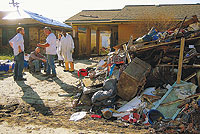
Weiner and a handful of Emergency Communities volunteers outside a gutted home in St. Bernard Parish. photo: Katherine Pangaro  Emergency Communities set up the site inside a geodesic domed-tent on the parking lot of an off-track betting parlor. Dubbed “The Made with Love Café,” it sheltered 80 volunteers as they served hot meals to up to 1,400 residents and relief workers a day. Nearby, smaller tents housed a grocery distribution center, Internet café, bicycle co-op and such offbeat relief services as acupuncture, haircuts and dance lessons. At night, it often hosted live concerts featuring fire dancers or brass bands. “You put a bunch of creative people together and you’re going to come up with some pretty interesting projects,” says Weiner. “Just the other day, we got a new volunteer in Buras who said, ‘I want to do massage.’ So we worked out a way to get a massage table donated. By them seeing that system, where there’s always room for people to step out, it allows people to build some of themselves into the organization.” Weiner spends a good chunk of his days on the phone with various businesses trying to convince them to donate goods. (In-kind donations made up half of Emergency Communities’ $1.3 million budget last year with the rest coming from grants and individual and corporate donations.) He floundered at first, but now has mastered the art of the ask. Weiner starts by introducing the organization and explaining its needs. Sometimes, he’ll list big-ticket items — seven or eight cases of diapers, toilets, stoves. When they backpedal, he says, “Or you could just send money, which is what we really need anyway. 
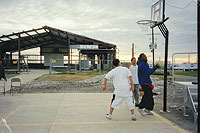
Youths play basketball with a new hoop installed by Emergency Communities as the sun sets on Diamond Trailer Park. photo: Martina Brendel ’05  “It was exciting,” says Weiner of the first few months. “People are so altruistic after something like Katrina happens. Everybody wants to help. A lot of people were grateful for the opportunity to donate things. In fact, it was a lot better then than it is now. All of these bureaucracies are in place. It’s so long after the storm, everything’s a little more difficult to get done now.” Weiner’s greatest challenge has been dealing with local politicians and business owners, some of whom have tried to shut down Emergency Communities. Last May, as The Made with Love Café was packing up for the hurricane season, Weiner received a call from the head of the department of recovery in St. Bernard asking if Emergency Communities would cook meals for Habitat for Humanity volunteers in Violet. FEMA was ending its direct services on June 1, and the parish risked losing all its relief workers. 
“He thinks it’s over,” said Johnson.“It’s not  Weiner agreed and sent a delegation of volunteers under Burwen’s direction. When they arrived, however, they felt judged by the parish board because of their youth and alternative appearance. A few times, they made the mistake of getting into political arguments with residents, resulting in complaints being brought against them. The work itself was also not nearly as rewarding as at The Made with Love Café. The volunteers felt more like a catering company than a relief organization. When the parish board asked Emergency Communities to leave in August, Weiner was happy to oblige. 
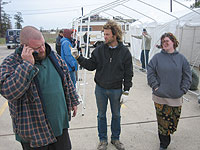
Mischa Byruck ’04 directs volunteers in the construction of a tent to store food at the Made with Love Café in St. Bernard Parish in January 2006. Photo: Valisa Higman  “It was a misstep,” says Weiner. “It was a good learning experience in what it is that we don’t do.” In January, Weiner learned that a similar situation was brewing in Buras. A handful of influential business owners were pressuring Parish President Billy Nungesser to close down the site — known as “The Y Café” because it is housed in a former YMCA — complaining that it was drawing away its customers. Weiner’s volunteers immediately began gathering petitions from residents in support of Emergency Communities. Within four days, they collected 307 petitions, including one from the local school principal. The residents praised Emergency Communities for the quality of its services and kindness of its volunteers, and feared for what they would do without the food and laundry facilities. One wrote, “It’s very important to keep this place open. Instead of thinking about closing it down, you could be thinking about how to help.” Weiner brought the letters with him to a meeting of local nonprofit leaders at Nungesser’s office in Belle Chasse. He listened patiently to Nungesser’s concerns, then presented him with the stack. “I think you should read these,” said Weiner. “Honestly, I didn’t feel as strongly about staying down here until I read these letters. They made me really sad.” Nungesser proposed they discuss their differences over a meal at The Y Café. 
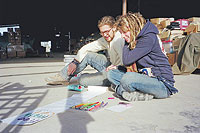
Volunteers Julie Hitchcock and Mark DiRuzza make a sign advertising a free health care clinic in East New Orleans. photo: Martina Brendel ’05  Afterward, Weiner exchanged handshakes and received words of encouragement from the other relief workers at the meeting. Among them was Bishop Wilfret Johnson, leader of a local Baptist church, who pulled him aside to thank him for all his hard work. “When we had nothing, and I mean all of nothing, Emergency Communities came in and set up a spot,” Johnson says. “Yes, it looked like M*A*S*H, but the kind of help they provided the people of this parish should never be underrated.” Their conversation then turned to the recent State of the Union address, during which President George Bush had omitted any reference to Katrina. “He thinks it’s over,” said Johnson. “It’s not over,” said Weiner. “It hasn’t started.” 
The next step for Emergency Communities is  Emergency Communities is leaving Buras at the end of May, when its United Way grant runs out. The hope, says Weiner, is to pass The Y Café to the residents so they can continue to operate it as a community center. “The services are merely a vehicle,” he says. “What people really like is the space.” 
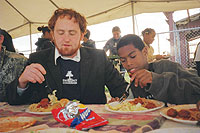
Weiner shares a meal with 11-year-old Trevone Ragas of Diamond Trailer Park. photo: Martina Brendel ’05  As money finally starts to arrive in residents’ hands through Gov. Kathleen Blanco’s “Road Home” grant program, Emergency Communities is shifting its focus from feeding to rebuilding. It has expanded its gutting services and is helping residents to navigate the permit process. Weiner also is putting the finishing touches on a mobile-response unit that can be driven to disaster areas and turned into a functional kitchen. “Hopefully, we’ll have that capacity, and if something does happen in the next year or two, we can respond to it,” he says. 
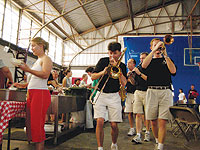
The “Pershing’s Own” U.S. Army Jazz Band plays at Emergency Communities’ last night in Violet. photo: Katherine Pangaro  The next step for Emergency Communities is to expand its reach beyond the Gulf Coast. Weiner sees the potential for emergency communities all over the world, in areas affected not just by natural disaster but war and famine. He also sees a place for the group in the United States, in poverty-stricken inner-cities or in towns where the local plant has just shut down. “While what we say we are is ‘Emergency Communities’ in that, in the absence of centers that would create a community, we’re there to create one. The truth is that many places in America don’t have any sense of community to begin with,” says Weiner. “What we’re creating is a step in the right direction. It’s creating a voice for people and a bond that they never had in the first place.” 
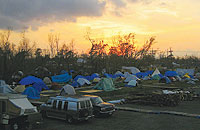
A view at dusk of the tents where volunteers at The Made with Love Café in St. Bernard Parish slept. photo: Katherine Pangaro  Ultimately, Weiner would like Emergency Communities to grow into a foundation that can give people funding to start their own relief sites. Once the kinks in his relief model are worked out, Weiner plans to condense it into a booklet that anyone with talent and motivation can use to start an emergency community. Weiner still cannot believe how large and effective Emergency Communities has become. Getting the organization off the ground has been a life-changing experience for everyone involved, he says. Byruck, who plans to pursue international disaster relief as a career, is one example. 
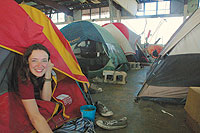
Volunteer Kate Mrozowski pokes her head out of a tent near The Y Café in Buras. photo: Katherine Pangaro  “I was an activist for seven months and not one person said ‘Thank you,’” says Byruck, who worked in Kansas City to register voters before the 2004 Presidential election. “That’s weird, because I got into politics to help people. The second I started doing real charity work, it made me feel good. I don’t want to stop.” Weiner is aware that just because he founded Emergency Communities, he may not always be the best person to lead it, in which case he is prepared to step down. Eventually, he would like to run for elected office — specifically, the Senate — but he no longer plans to attend law school. For now, though, he is committed to seeing Emergency Communities through the challenges that lie ahead. 
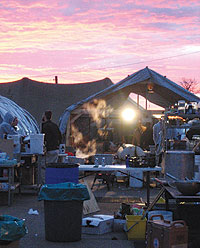
Cooking breakfast outside at The Made with Love Café in St. Bernard Parish. photo: Katherine Pangaro  “When you put a lot of creative people together with a lot of resilience and strong communities, you end up with a synergy that is mind-blowing, and that has been the reason we’ve been able to do as much as we have and help as many as we have,” he says. “I hope that after we leave these communities we will have made an impact on them in ways that aren’t related to the disaster but that have helped them as humans as much as they have helped us and our volunteers as humans.” Martina Brendel ’05 majored in political science. She is an education reporter for The Salem News in Beverly, Mass.
|
|
||||||||||||||||||||||||||||